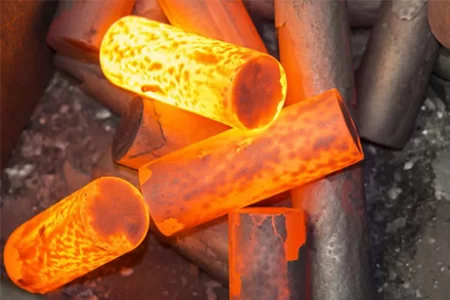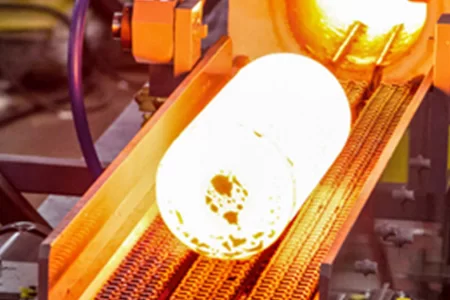By sharing knowledge, experience and views in the field of forging technology, we help you understand, learn and apply relevant technologies.

Hulk Metal Forging Technology
Share technical experience
-
Home>
-
Blog>
-
Technology>
What are the materials for hot forging?

Hot forging is a processing method that plastically deforms metal blanks by applying external force at high temperatures to obtain parts with the desired shape and mechanical properties. Hot forging is widely used in machinery manufacturing, the automobile industry, aerospace, energy equipment, construction machinery, and other fields. Different metal materials need to select appropriate hot forging process parameters due to their differences in physical and chemical properties. The following are several common hot forging materials and their characteristics and applications.
Steel
Carbon steel
Carbon steel refers to steel based on iron-carbon alloy and containing a small amount of other elements (such as manganese, silicon, etc.). According to the carbon content, carbon steel can be divided into low-carbon steel, medium-carbon steel, and high-carbon steel. Carbon steel has good plasticity and toughness, and low cost, and is widely used in the manufacture of various structural parts and mechanical parts.
Low carbon steel
The carbon content is below 0.25%, mainly used to manufacture parts that require low strength but good plasticity and toughness, such as bolts, nuts, chains, etc.
Medium carbon steel: The carbon content is between 0.25% and 0.60%, with high strength and hardness, and is often used to manufacture gears, shafts, connecting rods, and other parts that bear medium loads.
High carbon steel
The carbon content is above 0.60%, with high strength and hardness, but poor plasticity and toughness, suitable for manufacturing tools and molds that require high hardness and wear resistance, such as knives, files, etc.
Alloy steel
Alloy steel is based on carbon steel, by adding one or more alloying elements (such as chromium, nickel, molybdenum, vanadium, etc.) to improve the performance of steel. Alloy steel has higher strength, toughness, wear resistance, and corrosion resistance, and is suitable for manufacturing mechanical parts with higher requirements.
Low alloy steel
The total content of alloy elements is less than 5%, with good comprehensive mechanical properties, and is often used to manufacture high-strength bolts, steel structural components, etc.
Medium alloy steel
The total content of alloy elements is between 5% and 10%, with higher strength and toughness, suitable for manufacturing high-load bearings, gears, etc.
High alloy steel
The total content of alloy elements is more than 10%, with special properties, such as high-temperature alloys, corrosion-resistant alloys, etc., suitable for the manufacture of parts under extreme working conditions.
Stainless steel
Stainless steel is a type of steel containing alloy elements such as chromium and nickel, with excellent corrosion resistance. According to the different microstructures, stainless steel can be divided into austenitic stainless steel, martensitic stainless steel, and ferritic stainless steel.
Austenitic stainless steel
Contains high chromium and nickel, has excellent corrosion resistance and toughness, suitable for the manufacture of food processing equipment, chemical equipment, etc.
Martensitic stainless steel
Contains high carbon and chromium, has high strength and hardness, suitable for the manufacture of knives, valves, etc.
Ferritic stainless steel
Contains high chromium, has good corrosion resistance and magnetism, suitable for the manufacture of household appliances, automotive decorative parts, etc.
Magnesium alloy
Magnesium alloy is a lightweight alloy based on magnesium, formed by adding aluminum, zinc, manganese, and other elements. Magnesium alloy has the advantages of low density, high specific strength, and good heat dissipation performance, and is widely used in aerospace, automotive industry, electronic products, and other fields.
AZ series magnesium alloy
The main components are magnesium, aluminum, and zinc, with good casting performance and corrosion resistance, and are often used to manufacture automobile wheels, electronic equipment housings, etc.
AM series magnesium alloy
The main components are magnesium and manganese, with excellent oxidation resistance and mechanical properties, suitable for manufacturing aerospace parts, industrial equipment, etc.
The hot forging process of magnesium alloys requires controlling the forging temperature and speed to avoid oxidation or combustion of magnesium alloys due to high temperature. Usually, the forging temperature of magnesium alloys is between 300°C and 500°C, which is adjusted according to the specific alloy composition and workpiece shape.
Aluminum alloy
Aluminum alloy is a lightweight alloy formed by adding copper, magnesium, zinc, silicon, and other elements to aluminum as a matrix. Aluminum alloy has the advantages of low density, high specific strength and good corrosion resistance, and is widely used in aerospace, automotive industry, construction, packaging, and other fields.
2xxx series aluminum alloy
With copper as the main alloying element, it has high strength and good heat resistance and is suitable for manufacturing aviation structural parts, rocket parts, etc.
5xxx series aluminum alloy
magnesium is the main alloying element, with good corrosion resistance and weldability, often used in the manufacture of ship and vehicle shells, etc.
6xxx series aluminum alloy
magnesium and silicon are the main alloying elements, with good comprehensive properties, suitable for the manufacture of building profiles, mechanical parts, etc.
7xxx series aluminum alloy
zinc is the main alloying element, and contains a small amount of magnesium and copper, with extremely high strength, suitable for the manufacture of high-load structural parts, such as aircraft frames, bicycle frames, etc.
The hot forging process of aluminum alloys is generally carried out between 400°C and 500°C, and care should be taken to prevent oxidation and melting caused by overheating. Different series of aluminum alloys have different forging temperatures and process parameters due to differences in composition and performance.
Titanium alloy
Titanium alloy is a high-strength, corrosion-resistant, lightweight alloy based on titanium, formed by adding elements such as aluminum, vanadium, and molybdenum. Titanium alloys have the characteristics of high specific strength, good fatigue resistance, and high-temperature resistance, and are widely used in aerospace, medical equipment, chemical equipment, and other fields.
α-type titanium alloy
contains elements such as aluminum that stabilize the α phase, has good welding performance and corrosion resistance, and is suitable for manufacturing aircraft structural parts, chemical equipment, etc.
β-type titanium alloy
contains elements such as vanadium and chromium that stabilize the β phase, has good plasticity and hot processing performance, and is suitable for manufacturing aircraft engine parts, medical equipment, etc.
α+β-type titanium alloy
contains elements such as aluminum, vanadium, molybdenum, etc., has the advantages of both α-type and β-type titanium alloys, has high strength and good toughness, and is suitable for manufacturing aviation structural parts, ship parts, etc.
The hot forging process of titanium alloys needs to be carried out between 700°C and 950°C to avoid oxidation and hydrogen embrittlement of titanium at high temperatures. Titanium alloy forging needs to be carried out under inert gas protection to ensure its surface quality and mechanical properties.
Nickel alloy
Nickel alloy is a high-strength, corrosion-resistant alloy formed by adding elements such as chromium, molybdenum, aluminum, and titanium to nickel as a matrix. Nickel alloys have excellent high-temperature performance and oxidation resistance and are widely used in aerospace, chemical, energy, and other fields.
Inconel
The main components are nickel, chromium, and iron. It has excellent oxidation resistance and high-temperature strength. It is suitable for manufacturing aircraft engine turbine blades, chemical equipment, etc.
Monel
The main components are nickel and copper. It has good seawater corrosion resistance and mechanical properties. It is suitable for manufacturing ship parts, valves, etc.
Hastelloy
The main components are nickel, chromium, and molybdenum. It has excellent corrosion resistance and high-temperature oxidation resistance. It is suitable for manufacturing chemical equipment, nuclear power equipment, etc.
The hot forging process of nickel alloys needs to be carried out between 1000°C and 1200°C to ensure its high-temperature plasticity and mechanical properties. The forging of nickel alloys needs to be carried out under strictly controlled temperatures and strain rates to avoid hot cracks and uneven structure.
As an ancient and important metal processing technology, hot forging still occupies a pivotal position in modern manufacturing. Through the hot forging of various materials, we can obtain parts with excellent mechanical properties and complex shapes to meet the needs of different industries. From carbon steel, alloy steel, and stainless steel, to magnesium alloy, aluminum alloy, titanium alloy, and nickel alloy, the application of each material in hot forging technology has shown its unique advantages and broad application prospects. With the continuous advancement of technology, hot forging technology will be innovated and developed in more new materials and new fields, contributing more to the progress of global industry. In the future, we look forward to seeing hot forging technology make greater breakthroughs in efficient, precise, and green manufacturing, bringing better products and solutions to all walks of life.
Article Navigation
Article Navigation
Industries
Foundries
-

July.26, 2024
What kind of inspections should be done before choosing a wire gripper?
READ MORE
-

July.15, 2024
Wire Cable Grips: Types, Mechanisms, and Applications
READ MORE
-

June.27, 2024
What are the advantages and disadvantages of the hot forging process?
READ MORE
-

July.25, 2024
How to Choose the Perfect Cable Grips for Your Needs?
READ MORE
-

July.03, 2024
What are the processes of hot forging?
READ MORE







